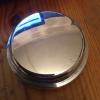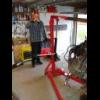Balljoint Shimming
#16

Posted 10 March 2013 - 11:16 AM
#17

Posted 10 March 2013 - 01:02 PM
#18

Posted 10 March 2013 - 01:13 PM
I can't recomend it enough, new ball joints are cheap but well worth doing the job. After all you wouldn't refit worn out discs or pads etc.. Well I hope you wouldn't anyway
#19

Posted 10 March 2013 - 03:12 PM
DO MAKE SURE ALL traces of grinding paste are removed, i use a mixture of products to do this and also change my cleaning paper each time.
#20

Posted 10 March 2013 - 03:56 PM
Thanks,
Bob
#21

Posted 10 March 2013 - 05:06 PM
I keep seeing references to a UTube video about using an electric drill to speed up the lapping in process but all the links I have tried end up as 'Private'. Anyone got a live link?
Thanks,
Bob
That is a seriously bad method, as you lose the control and its far too fast, it causes hot spots that can lead to breakdown of the heat treatment.
As the surface has minute high spots, these can get very hot, but being so small they are unnoticeable to the human eye, the se high spots rub together and cause microscopic areas to heat up, heating causes them to expand and therefore the whole increases and you get a smeared surface this is very bad for smoothness of operation.
#22

Posted 10 March 2013 - 05:11 PM
I just spent a while looking for the link....not sure why it isn't live anymore.
( why is my font so small now )
The drill isn't going fast at all while lapping...not fast enough to create any heat (much)
Edited by Deathrow, 22 June 2017 - 02:32 PM.
Removed formatting.
#23

Posted 10 March 2013 - 05:14 PM
I was thinking that the only turning action will be between the top shim and the cup, the bottom shim and the hub itself won't be turning but i understand what you mean. I will order new joints but may try a bit more work on one of the old joints to see if i can get it better, just out of curiosity! Thanks for the help, the advice you guys freely dish out is invaluble!What I meant was place the thicker shims either side of the thinner shims.... making a thin shim sandwich.
I can't recomend it enough, new ball joints are cheap but well worth doing the job. After all you wouldn't refit worn out discs or pads etc.. Well I hope you wouldn't anyway
#24

Posted 10 March 2013 - 05:16 PM
I just spent a while looking for the link....not sure why it isn't live anymore.
( why is my font so small now )
The drill isn't going fast at all while lapping...not fast enough to create any heat (much)
Unfortunately it is, its on a microscopic level it wouldn't be easy to see, or feel. but it happens, and how fast do you think the drill is turning at ?
A lot of people reading this may assume that the drill has to run at the slowest possible setting that the drill has, that is still about 10 times faster than my lapping machine will run at on FULL speed !
And as above 30 minutes each by hand and you get far better results.
Maybe the link has been removed due to safety issues ?
Edited by mra-minis.co.uk, 10 March 2013 - 05:18 PM.
#25

Posted 10 March 2013 - 05:39 PM
Serious question - if there is a 'best way' that's the one we should practice and promote.
Bob
#26

Posted 10 March 2013 - 06:01 PM
So, for those of us who don't have a lapping machine, how should the job be done? 'By hand' is fair enough, but while we have all seen/got a wooden stick with suction rubbers on it for lapping valves, how do you manage an upstanding bolt (perhaps with a nut on it).
Serious question - if there is a 'best way' that's the one we should practice and promote.
Bob
Hi Bob,
I do have a lapping machine yet I choose to do them by hand
#27

Posted 10 March 2013 - 06:03 PM
You are trying to move in a figure of eight in 360 degrees to get an even lapping in process.
#28

Posted 10 March 2013 - 06:52 PM
A bit of hose and a valve lapping stick, the cheap wooden ones are best for this task
You are trying to move in a figure of eight in 360 degrees to get an even lapping in process.
That is what I wanted to know. Many thanks.
Bob
#29

Posted 10 March 2013 - 07:26 PM
#30

Posted 10 March 2013 - 08:21 PM
First, if you run the drill "forward" you have to very carefully throttle both the drill's trigger and the wrench you are holding the nut with. This is not so much for speed control but for torque control. As you tighten the nut, if it gets just a tiny bit too tight the nut tightens itself further which can rip the drill out of your hand. Meanwhile, you have the chuck clamped on the threads of the stud so that's not helping either, especially if the chuck slips.
I have lapped 3 or 4 sets with a drill but I have made some special tools to hold the hub in a vice, another tool to thread onto the stud to protect its threads, and I set my drill on the lowest speed as Spitz suggested. Electric drill lapping can be made to work but I would never encourage anyone to try it if they were not mechanically inclined. I have had two "students" come to my house to use the tools I made for this task. While I had them do the work I stood over them and watched each step so they wouldn't hurt themselves or ruin the parts.
I saw the YouTube video years ago before it was pulled or made private. It showed the basics of the method but did not warn against speed or torque, nor did it show the "wobbly" figure-8 motion that Martin mentioned. I was told the video was pulled for liability reasons. Perhaps this is true but I have no first hand knowledge of why the video was really pulled.
1 user(s) are reading this topic
0 members, 1 guests, 0 anonymous users


















